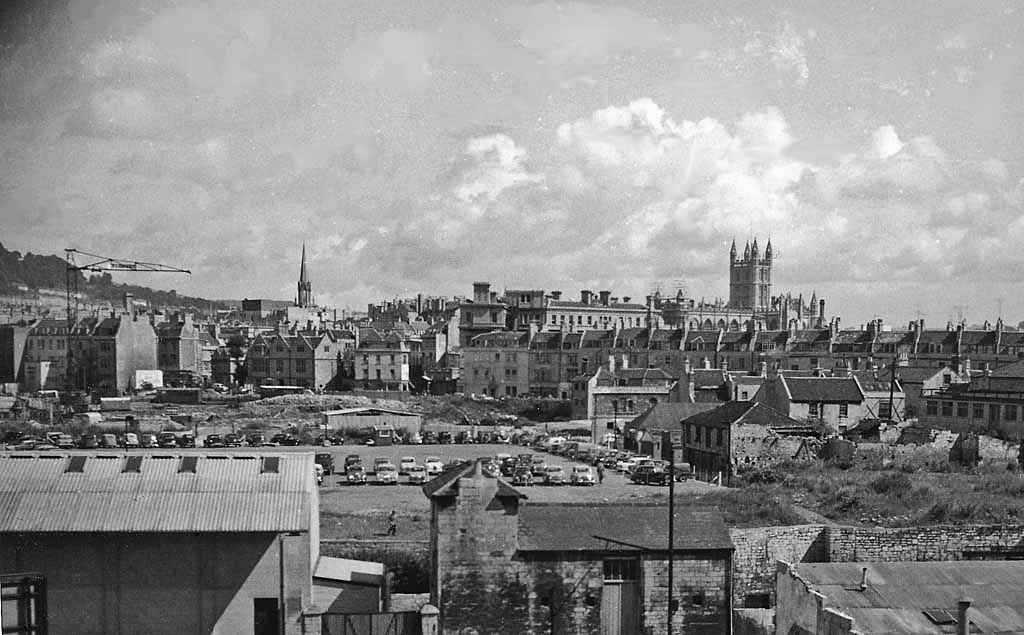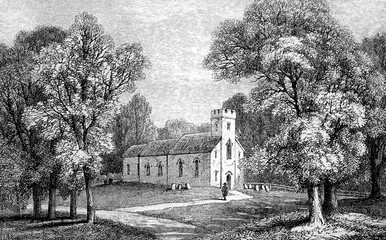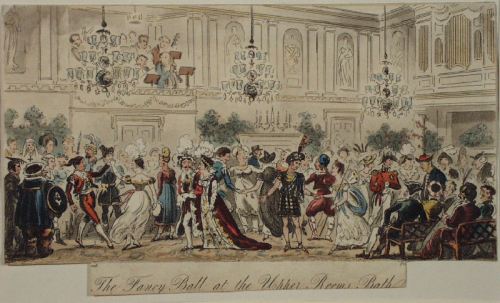|
Bath, Somerset
Bath (Received Pronunciation, RP: ; ) is a city in the Bath and North East Somerset unitary area in the ceremonial counties of England, county of Somerset, England, known for and named after its Roman Baths (Bath), Roman-built baths. At the 2021 Census, the population was 101,557. Bath is in the valley of the River Avon (Bristol), River Avon, west of London and southeast of Bristol. The city became a World Heritage Site in 1987, and was later added to the transnational World Heritage Site known as the "Great Spa Towns of Europe" in 2021. Bath is also the largest city and settlement in Somerset. The city became a spa with the Latin name ' ("the waters of Sulis") 60 AD when the Romans built Roman Baths (Bath), baths and a temple in the valley of the River Avon, although List of geothermal springs in the United Kingdom, hot springs were known even before then. Bath Abbey was founded in the 7th century and became a religious centre; the building was rebuilt in the 12th and ... [...More Info...] [...Related Items...] OR: [Wikipedia] [Google] [Baidu] |
Pulteney Bridge
Pulteney Bridge is a bridge over the River Avon in Bath, England. It was completed by 1774, and connected the city with the land of the Pulteney family which it wished to develop. Designed by Robert Adam in a Palladian style, it is highly unusual in that it has shops built across its full span on both sides. It has been designated as a Grade I listed building. Within 20 years of its construction, alterations were made that expanded the shops and changed the façades. By the end of the 18th century, it had been damaged by floods, but was rebuilt to a similar design. Over the next century alterations to the shops included cantilevered extensions on the bridge's north face. In the 20th century, several schemes were carried out to preserve the bridge and partially return it to its original appearance, enhancing its appeal as a tourist attraction. The bridge is now long and wide. Although there have been plans to pedestrianise the bridge, it is still used by buses and taxis. The ... [...More Info...] [...Related Items...] OR: [Wikipedia] [Google] [Baidu] |
List Of Geothermal Springs In The United Kingdom
This is a list of geothermal springs in the United Kingdom, otherwise known as warm springs and hot springs (defined as those hotter than 37 degrees C): England * Bakewell British Legion *Bakewell Recreation Ground * Bath * Beresford Dale, River Dove * Bradwell Spring *Crich, Meerbrook Sough, Leashaw Farm *Crich, Ridgeway Sough, Whatstandwell *Cross Bath, Bath, Somerset *Droitwich Spa, Worcestershire *The Hetling Spring, Bath, Somerset * Hotwells, Bristol *The King's Bath, Bath, Somerset *Lower Dimindale, Derbyshire * Matlock, Derbyshire Thermal springs * St Ann's Well, Buxton, Derbyshire *Stall Street Fountain, Bath, Somerset *Stoke Sough, Grindleford *Stoney Middleton Wales * Taff's Well Thermal Spring, Rhondda Cynon Taff, South Wales See also * List of spa towns in the United Kingdom References {{Reflist, refs= {{cite web , url = http://smhccg.org/listed-buildings/roman-bath-house/ , title = Roman Bath House , last = Smith , first = Barry , ... [...More Info...] [...Related Items...] OR: [Wikipedia] [Google] [Baidu] |
Avon (county)
Avon () was a non-metropolitan and ceremonial county in the west of England that existed between 1974 and 1996. The county was named after the River Avon, which flows through the area. It was formed from the county boroughs of Bristol and Bath, together with parts of the administrative counties of Gloucestershire and Somerset. In 1996, the county was abolished and the area split between four new unitary authorities: Bath and North East Somerset, Bristol, North Somerset and South Gloucestershire. The Avon name is still used for some purposes. The area had a population of approximately 1.08 million people in 2009. Background The port of Bristol lies close to the mouth of the River Avon which formed the historic boundary between Gloucestershire and Somerset. In 1373, a charter constituted the area as the County of the Town of Bristol, although it continued to fall within the jurisdiction of the two counties for some purposes. The appointment of a boundaries commission in 1 ... [...More Info...] [...Related Items...] OR: [Wikipedia] [Google] [Baidu] |
Bath Blitz
The term Bath Blitz refers to the air raids by the German ''Luftwaffe'' on the British city of Bath, Somerset, during World War II. The city was bombed in April 1942 as part of the so-called "Baedeker raids", in which targets were chosen for their cultural and historical, rather than their strategic or military, value. Background Bath was subject to numerous air raid warnings during the Blitz, the German night bombing offensive against Britain's cities, as raiders flew overhead on their way to nearby Bristol which was bombed severely throughout the period, and several bombs fell on Bath during 1940 and 1941. However, the city remained largely untouched until April 1942 and the start of the Baedeker Blitz, mounted in response to a step-change in the effectiveness of the RAF's bombing offensive in March 1942 which resulted in the destruction of the city of Lübeck. The Blitz Over the weekend of 25–27 April 1942, Bath suffered three raids, from 80 ''Luftwaffe'' aircraft which ... [...More Info...] [...Related Items...] OR: [Wikipedia] [Google] [Baidu] |
Jane Austen
Jane Austen (; 16 December 1775 – 18 July 1817) was an English novelist known primarily for her six major novels, which interpret, critique, and comment upon the British landed gentry at the end of the 18th century. Austen's plots often explore the dependence of women on marriage in the pursuit of favourable social standing and economic security. Her works critique the novels of sensibility of the second half of the 18th century and are part of the transition to 19th-century literary realism. Her use of biting irony, along with her realism and social commentary, have earned her acclaim among critics, scholars and readers alike. With the publication of ''Sense and Sensibility'' (1811), '' Pride and Prejudice'' (1813), ''Mansfield Park'' (1814), and '' Emma'' (1816), she achieved modest success but only little fame in her lifetime since the books were published anonymously. She wrote two other novels—''Northanger Abbey'' and '' Persuasion'', both published posthumou ... [...More Info...] [...Related Items...] OR: [Wikipedia] [Google] [Baidu] |
John Wood, The Elder
John Wood, the Elder (1704 – 23 May 1754) was an English architect, working mainly in Bath. In 1740 he surveyed Stonehenge and the Stanton Drew stone circles. He later wrote extensively about Bladud and Neo-Druidism. Because of some of his designs he is also thought to have been involved in the early years of Freemasonry. His notable work in Bath included: St John's Hospital, Queen Square, Prior Park, The Royal Mineral Water Hospital, the North and South Parades and The Circus. Wood also designed important buildings outside Bath, including the reconstruction of Llandaff Cathedral, Buckland House, The Exchange, Bristol, and Liverpool Town Hall. He has been described by Nikolaus Pevsner as "one of the outstanding architects of the day". Early life Wood was born in Twerton near Bath, and baptised in St. James's Church (now demolished). He received a good but basic education at King Edward's School. His father George was a local builder. During his teenage year ... [...More Info...] [...Related Items...] OR: [Wikipedia] [Google] [Baidu] |
Beau Nash
Beau Nash (18 October 1674 – 3 February 1762), born Richard Nash, was a celebrated dandy and leader of fashion in 18th-century Britain. He is best remembered as the Master of Ceremonies at the spa town of Bath. Biography Nash was born in St Mary's Street, Swansea, in 1674. His father, Richard, a native of Pembroke, had risen to be partner in a glass-works at Swansea, which- although he was "of modest means"- gave him the means to pay for his son's education. Nash's mother was a niece of the Welsh merchant John Poyer, who was mayor of Pembroke town and served during the English Civil War. The Nash family were "known" in the countryside, but the Poyer family was of "gentler blood". Nash's comparatively obscure origins were sometimes the subject of comment; when the Duchess of Marlborough mentioned it, Nash replied "Madam, I seldom mention my father in company, not because I have any reason to be ashamed of him, but because he has some reason to be ashamed of me." After at ... [...More Info...] [...Related Items...] OR: [Wikipedia] [Google] [Baidu] |
Bath Assembly Rooms
The Bath Assembly Rooms, designed by John Wood the Younger in 1769, are a set of assembly rooms located in the heart of the World Heritage City of Bath in England which are now open to the public as a visitor attraction. They are designated as a Grade I listed building. During the Georgian era Bath became fashionable, and the architects John Wood, the Elder, and his son laid out new areas of housing for residents and visitors. Assembly rooms had been built early in the 18th century, but a new venue for balls, concerts and gambling was envisaged in the area between Queen Square, The Circus and the Royal Crescent. Robert Adam submitted a proposal that was rejected as too expensive. John Wood, the Younger raised funding through a tontine, and construction started in 1769. The new or upper assembly rooms opened with a grand ball in 1771 and became the hub of fashionable society, being frequented by Jane Austen and Charles Dickens, along with the nobility of the time. The bu ... [...More Info...] [...Related Items...] OR: [Wikipedia] [Google] [Baidu] |
Grand Pump Room, Bath
The Grand Pump Room is a historic building in the Abbey Churchyard, Bath, Somerset, England. It is adjacent to the Roman Baths and is named for water that is pumped into the room from the baths' hot springs. Visitors can drink the water or have other refreshments while there. It has been designated as a Grade I listed building since 1950. Along with the Lower Assembly Rooms, it formed a complex where social activity was centred, and where visitors to the city gathered. History The present building replaced an earlier one on the same site, designed by John Harvey at the request of Beau Nash, Bath's master of ceremonies, in 1706, before the discovery of Roman remains nearby. The main block, built of Bath stone, was begun by Thomas Baldwin, and the foundations of a Roman temple precinct were discovered during preparatory excavations. The North Colonnade of nine bays, with unfluted Ionic columns, was built by Baldwin in 1786–1790. Baldwin was dismissed, as a result of fina ... [...More Info...] [...Related Items...] OR: [Wikipedia] [Google] [Baidu] |
The Circus, Bath
The Circus is a historic ring of large townhouses in the city of Bath, Somerset, England, forming a circle with three entrances. Designed by architect John Wood, the Elder, it was built between 1754 and 1769, and is regarded as a pre-eminent example of Georgian architecture. The name comes from the Latin ''circus'', meaning a ring, oval or circle. It has been designated as a Grade I listed building. The Circus is divided into three segments of equal length, with a lawn in the centre. Each segment faces one of the three entrances, ensuring a classical façade is always presented straight ahead. History The Circus, originally called King's Circus, was designed by the architect John Wood, the Elder. Convinced that Bath had been the principal centre of Druid activity in Britain, Wood surveyed Stonehenge, which has a diameter of at the outer earth bank, and designed the Circus with a diameter to mimic this. Wood died less than three months after the first stone was laid; hi ... [...More Info...] [...Related Items...] OR: [Wikipedia] [Google] [Baidu] |
Royal Crescent
The Royal Crescent is a row of 30 terraced houses laid out in a sweeping Crescent (architecture), crescent in the city of Bath, Somerset, Bath, England. Designed by the architect John Wood, the Younger and built between 1767 and 1774, it is among the greatest examples of Georgian architecture to be found in the United Kingdom and is a Grade I listed building. Although some changes have been made to the various interiors over the years, the Georgian stone facade remains much as it was when first built. The crescent has 114 Ionic order, Ionic columns on the first floor with an entablature in a Palladian architecture, Palladian style above. It was the first crescent of terraced houses to be built and an example of "''wikt:rus in urbe, rus in urbe''" (the country in the city) with its views over the parkland opposite. Many notable people have either lived or stayed in the Royal Crescent since it was built over 240 years ago, and some are commemorated on special plaques attached ... [...More Info...] [...Related Items...] OR: [Wikipedia] [Google] [Baidu] |
Bath Stone
Bath Stone is an oolitic limestone comprising granular fragments of calcium carbonate. Originally obtained from the Combe Down and Bathampton Down Mines under Combe Down, Somerset, England. Its honey colouring gives the World Heritage City of Bath, England its distinctive appearance. An important feature of Bath Stone is that it is a ' freestone', so-called because it can be sawn or 'squared up' in any direction, unlike other rocks such as slate, which form distinct layers. Bath Stone has been used extensively as a building material throughout southern England, for churches, houses, and public buildings such as railway stations. Some quarries are still in use, but the majority have been converted to other purposes or are being filled in. Geological formation Bath Stone is an oolitic limestone comprising granular fragments of calcium carbonate laid down during the Jurassic Period (195 to 135 million years ago) when the region that is now Bath was under a shallow sea. Layer ... [...More Info...] [...Related Items...] OR: [Wikipedia] [Google] [Baidu] |









